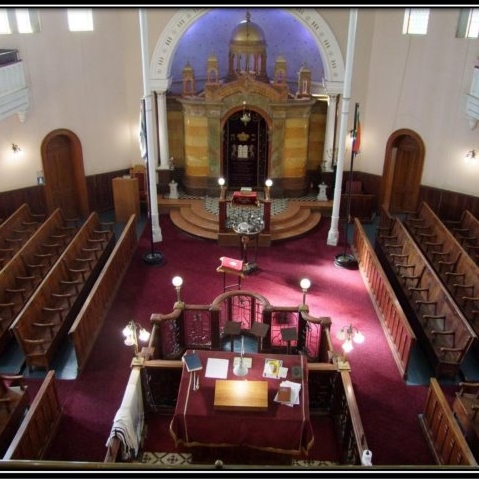click to dowload our latest edition
CLICK HERE TO SUBSCRIBE TO OUR NEWSLETTER


Published
7 years agoon
By
adminSUZANNE BELLING
Former Kimberley residents and other interested parties have attended reunions over the past years, including the congregation’s 110th anniversary in 2012, and every Rosh Hashanah the congregation almost doubles in size.
Solid as the stone for which Kimberley is famed, is Adrian “Barney” Horwitz, chairman and CEO of the congregation, a lawyer with a practice in the city. He and Barry Katz, from and old Kimberley family, are largely responsible for conducting services. The trio which runs the Jewish community is complemented by David Allen, of the GWHC.
Horwitz is a keen historian and is in demand for his talks on Kimberley and the significance of what he terms the “Jewish sojourn” there.
Kimberley’s Jewish community produced six mayors between 1906 and 1967, including William Sagar, Justiceof the Peace, Ernest (later Sir Ernest) Oppenheimer, Bernard Cohen, Gustave “Gus” Bowman Haberfeld, Lionel Jawno and Cecil Jack Sussman, some of whom served for more than one term.
Colonel Sir David Harris – known as “The Grand Old Man of South African Jewry” – a director of De Beers and commander of the Kimberley Town Guard during the siege in 1900 – was MP for Kimberley and Griqualand West in the old Cape Parliament and subsequently in the Union Parliament.
Sir Ernest Oppenheimer who moved his residence from Kimberley in 1916 succeeded Sir David Harris, remaining an MP until 1938.
A malicious rumour that did the rounds regarding the Oppenheimer family and the Kimberley Shul has finally been debunked as loshen hora.
The Oppenheimers had been active in Kimberley and the congregation. Ernest’s son Harry was born and had had his bris there. However, on the death of Harry’s mother, May, Sir Ernest married Caroline “Ina” Harvey and the family converted to Christianity.
The story goes that the Oppenheimer family had put up a plaque in the shul to mark Harry’s barmitzvah and because they no longer practised Judaism asked for the plaque to be removed. When the congregation refused, the Oppenheimers were said to have offered to buy the synagogue, raze it and have it rebuilt at their cost – minus the plaque.
“No such thing happened. There never was a plaque. Plus the records show – to which Barney Horwitz attests – the family left Kimberley when Harry was 11, he didn’t have a barmitzvah there or anywhere else for that matter,” says Rabbi Moshe Silberhaft, country communities rabbi of the Board of Deputies, who ministers to the Jews of Kimberley.
The Kimberley Synagogue was built on land donated by De Beers. The original shul building was a somewhat primitive galvanised iron structure on the site of the present Cecil John Rhodes memorial statue.
The Kimberley Synagogue, to many, is the most beautiful in southern Africa – Byzantine in style and modelled on a shul in Venice.
In July 1902 GH Bonas, president of the congregation, laid the foundation stone. The shul was officially opened in mid-September 1902. The next month, Bonas was presented with a solid silver replica of the synagogue in appreciation of his work for the congregation.
Many years later, this valuable replica, was discovered in a London pawnshop by a congregant, who serendipitously was visiting the United Kingdom. It was immediately bought and returned to Kimberley. It is now on loan to the Cape Town Jewish Museum.
The synagogue today is one of few in South Africa to be in use for over 100 years. However, the Kimberley Jewish community itself dates back to 1873. Even before that there is a record of individual Jews having settled in the city.
The main feature of the synagogue, with its ornate stained-glass windows, is an imposing domed ceiling, depicted as a blue sky with stars. Marble steps lead to the Aron Kodesh, the surrounds of which are painted to resemble marble. There are 613 seats in the shul, symbolising the mitzvot of that number.
Twelve Sifrei Torah enable every male in the congregation to have a chance to walk around the bimah during the Simchat Torah hakafot.
There is a famous yad (hand or pointer to read the Torah), with a blue white diamond set on the forefinger.
There are two Jewish cemeteries in Kimberley. One has been walled in to keep out vandals, but the West End Cemetery is still in use.
During the 1990s Horwitz arranged, through a Muslim “contact”, for observant graduate medical doctors to do their prescribed community service at a hospital in Kimberley. Instead of staying in doctors’ quarters at the hospital, they stayed in the shul house.
The last spiritual leader – the Rev Shmuel Kruglak – left in the early 1990s and Rabbi Silberhaft stepped in in 1996. Among the spiritual leaders was the Rev Joe Matzner, who served Kimberley during the seventies and now lives in Johannesburg.

Leon Chonin
Feb 4, 2017 at 2:06 am
‘I was born and raised in Kimberley but left after matriculating to attend university. My grandparents and my father are buried there. ‘
Geraldine Auerbach (nee Kretzmar)
Feb 8, 2017 at 12:27 pm
‘A website has been created for the Kimberley Jewish Community. It has a timeline and stories about the pioneers and families who settled there over the decades. There are beautiful picture galleries of the synagogue and every grave in each of the cemeteries has been photographed. If you have a kimberley story to share, please contact geraldine.auerbach@gmail.com
\nYou can see the website here:
\nhttp://kehilalinks.jewishgen.org/kimberley/Home.html‘
Merwyn Jacobson
Dec 19, 2017 at 7:17 am
‘My grandfather, Adolph Jacobson, died in Kimberley in the early 1920s. I am trying to find a record of his grave. Any help would be appreciated. Thank you in anticipation.’